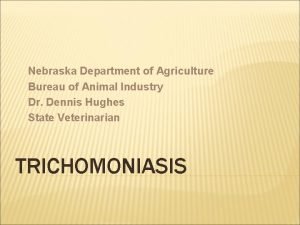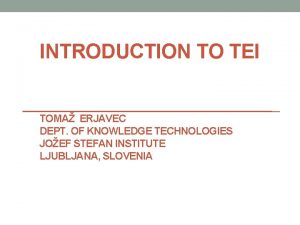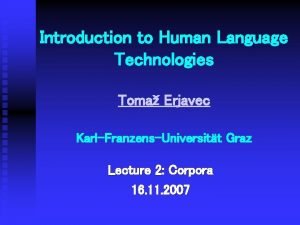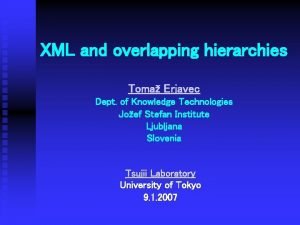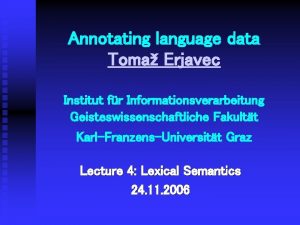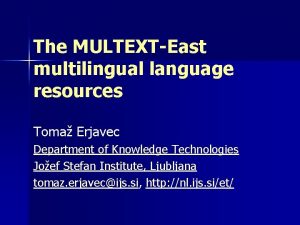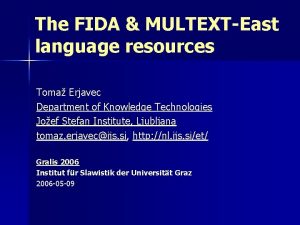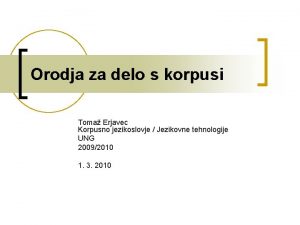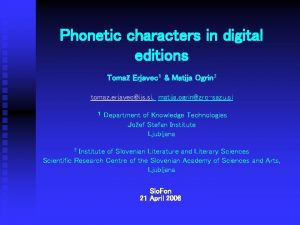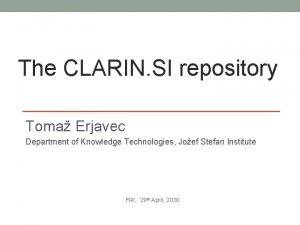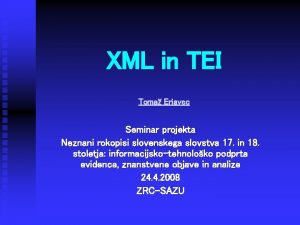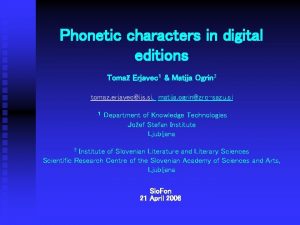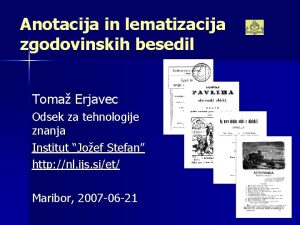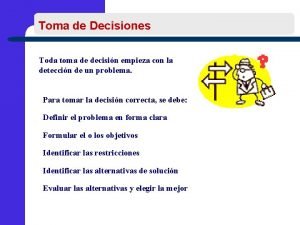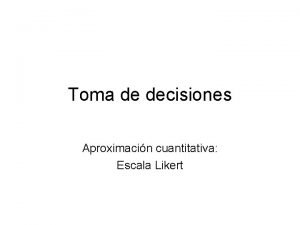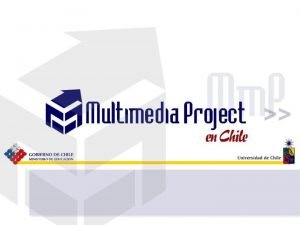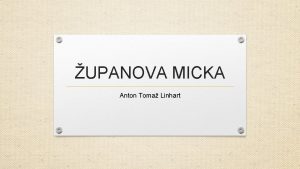Language Technologies Toma Erjavec Dept of Knowledge Technologies

































- Slides: 33

Language Technologies Tomaž Erjavec Dept. of Knowledge Technologies Jožef Stefan Institute The Janes project Module "Knowledge Technologies" Jožef Stefan International Postgraduate School 2016 / 2017

Janes project • National basic research project „Resources, Tools and Methods for the Research of Nonstandard Internet Slovene“ (J 6― 6842) • 3 yr, 2014 -2017 • Lead: Dept. of Translation, Faculty of Arts, Uni. of Ljubljana (Darja Fišer) • Also: Jožef Stefan Institute, E 8 • 8 team members • http: //nl. ijs. si/janes

Research goals § WP 1: Corpus construction § WP 2: Linguistic analysis – Task 1: vs. standard Slovene • orthography (spelling, capitalization, punctuation) • regional variation • shortening strategies • syntax – Task 2: vs. spoken Slovene • discourse markers • interactive elements – Task 3: collocations • new collocations of old words • collocations of new words • dictionary of Twitterese – Task 4: terminology • specialisation level & density • nonstandard elements in terminology – Task 5: semantic shifts • sense expansion/narrowing/shifting • amelioration/pejoration • neologisms – Task 6: offensive language • refugee crisis • gay marriage § WP 3: NLP tools

Constructing the Janes Corpus § First large corpus of Slovene user-generated content § 5 text types of public user-generated content: 1. 2. 3. 4. 5. tweets forum posts user comments on on-line news portals blog posts along with user comments on these blogs talk and user pages from Wikipedia 1. 2. 3. 4. 5. 6. identify texts to be harvested (URLs) harvest clean (character encoding, boilerplate) structure (e. g. threads in forums) add basic metadata (time of post, user/author) additional metadata § Each text type harvested with specialised crawler:

Tweets • • Tweet. Cat (Ljubešić et al. 2014) Twitter API Slovene-specific seed words -> Slovene users -> their network metadata: username, time stamp, no. of retweets & favourites • še, kaj, že, če, ampak, mogoče, jutri, zdaj, vendar, kje, oziroma, tudi, sploh, spet, všeč, ravnokar, končno, kdaj, preveč & očitno

Forums • • 3 forums: med. over. net, avtomobilizem. com, kvarkadabra. net customized extractors (Beautiful Soup) metadata: topic, post URL, post time stamp, username, post id preserve structure of threads

News & news comments • • 3 news portals: RTV Slo, Mladina, Reporter customized extractors (Beautiful Soup) metadata: article url, article id, username, post time stamp, post id keep news article and comment thread

Blog posts & blog comments • • 2 blog sites: publishwall. si, rtvslo. si customized extractors (Beautiful Soup) metadata: post URL, post time stamp, username, post id keep blog and comment thread

Wikipedia talk & user pages • Wikitalk extractor (Ljubešić 2016) • use dump of Wikipedia • based on language-specific codes for username (“uporabnik”) & language (“sl”) • minimalistic post segmentation

Janes corpus in numbers

Metadata in the Janes corpus § Metadata = data about data, i. e. data on texts § Allows much more interesting analyses § Some extracted directly from harvested documents (e. g. number of retweets) § Some extracted with simple heuristics (username, date of post) § Some added manually (sex & type of user) § Some added with machine learning methods (standardness, sentiment)

Language of texts • langid. py + heuristics

Age of texts

Types of users Gender of users • manual annotation • only for Twitter & blog posts Types of users on Twitter • manual annotation • private: 76% • corporate: 24% • 84% neutral • 13% male • 3% female

Corporate vs. private users

Region of users on Twitter (Čibej & Ljubešić 2015) • automatic annotation • 22% of all users • 2% of all tweets • 7 regions Maribor Panonska Rovtarska Koroška Primorska Dolenjska Tujina Gorenjska Štajerska Ljubljana

Text standardness

Text standardness § Training dataset • Manual annotation, 1 day hackathon, 6 students • 900 texts single annotated (development set) • 400 texts double-annotated (testing set) § Feature selection (29 features) – character-based: • • • repetitions of characters ratio of alphabetic vs. non-alphabetic characters ratio of vowels vs. consonants – token-based: • • • proportion of very short words proportion capitalised words proportion of words not included the Sloleks lexicon § Regressor – grid search hyperparameter optimisation via 10 -fold cross-validation on the SVR regressor using RBF kernel § Evaluation – mean absolute error: 0. 377 T, 0. 424 L

Text standardness on Twitter

Text sentiment • automatic annotation with SVM • large manually labelled Twitter dataset • Smailović 2014

Sentiment on Twitter

Linguistic processing 1. Sentence segmentation & tokenization – To je ok. → To + ␣ + je + ␣ + ok +. 2. Rediacritization – On se se vedno rezi! → On se še vedno reži! 3. Normalization – jest, jas, js → jaz 4. Tagging & lemmatization – časa → Ncmsg + čas

Linguistic processing 1. § § Tokenization & sentence segmentation Token: one occurrence of a word or punctuation symbol Typically first tool to apply to text More difficult than it looks, esp. for non-standard text: – Hello, Mr. President! – moram tukaj pisati? : -)no se bom mal opisala pač tko. . kokrkol : -) § Combination of classic & optional regex rules for nonstandard language § Evaluation: – token - very good (99. 2%) – sentence - room for improvement (86. 3%)

Linguistic processing 2. § Rediacritization § In general difficult: – Out-of-Vocabulary words – Ambiguous words: Problem je resen. § § § (Ljubešić in dr. 2016) Machine learning approach: Ken. LM Easy to acquire training data: strip diacritic from regular corpus Translation model + Language model (context!) Evaluation: Wikipedia 99. 62%, tweets 99. 12%

Linguistic processing 3. § § Normalization Standardise non-standard words in text Character-based statistical machine translation Manually annotated training set: 4. 000 tweets, 100. 000 words

Linguistic processing 5. § § § § § MSD tagging & lemmatization Performed on normalised text Use of MULTEXT-East MSD tagset for Slovene (1900 tags) New tags for CMC-specific elements (e-mails, URLs, emoji, hashtags, mentions) (Ljubešić in Erjavec 2016) Conditional random fields & lexicon used as a feature Trained on ssj 500 k manually annotated corpus Evaluation: 94. 3%, Error reduction to previous best result: 25%

Corpus Encoding § Janes XML schema for structure and metadata <wikipedia xml: id="janes. wikipedia. pagetalk"> <page xml: id="janes. wikipedia. pagetalk. 1" url = "https: //sl. wikipedia. org/wiki/Pogovor: Glavna_stran/Arhiv_junij_2006"> <title>Pogovor: Glavna stran/Arhiv junij 2006</title> <topic xml: id="janes. wikipedia. pagetalk. 1. 1"> <title>Pogovor: Glavna stran/Arhiv junij 2006</title> <comment xml: id="janes. wikipedia. pagetalk. 1. 1. 1" xml: lang="slv" std_tech="T 1" std_tech_n="1. 6" std_ling="L 1" std_ling_n="1. 3" sentiment="neutral"> <text> <p xml: id="janes. wikipedia. pagetalk. 1. 1">O vsebinah glavne strani se dogovarjamo na Wikipedija: Glavna stran. </p>

Linguistic annotation § Text in XML according to TEI P 5

Janes in (no)Sketch. Engine

Manual annotation of the Janes reference datasets § Goals: – Manually annotated datasets are needed for machine learning of annotation tools and their testing – Also need for corpus-based linguistic investigations where results of automatic methods are to imprecise or automatic methods do not even exists § § § Results for ML of linguistic annotation (already available in CLARIN. SI): 1. Janes-Norm: tokenization, sentence splitting, normalisation 2. Janes-Tag: MSD tagging and lemmatisation 3. Janes-Syn: syntactic annotation Results for linguistic investigations: 1. Janes-Kratko: shortening strategies in tweets 2. Janes-Vejica: placement of comma in tweets 3. Janes-Preklop: code-switching in tweets Annotation campaigns – – – Annotation guidelines Annotator training Annotation Curation Export to TEI

Manual annotation in Web. Anno

Further work § Corpus enhancement – encoding enhancement (document structure, CMC-specific) – monitor corpus (Twitter) § Small dictionary of Twitterese § Corpus dissemination – problems (terms of user, copyright, privacy) – solutions (anonymization, shuffling, sampling)

§ More on http: //nl. ijs. si/janes/
 Tedovit
Tedovit Gimnazija jesenice
Gimnazija jesenice Dept nmr spectroscopy
Dept nmr spectroscopy Fl dept of agriculture
Fl dept of agriculture Finance departments
Finance departments Inspectors in worcester
Inspectors in worcester Dept. name of organization (of affiliation)
Dept. name of organization (of affiliation) Mn dept of education
Mn dept of education Department of finance and administration
Department of finance and administration Dept. name of organization (of affiliation)
Dept. name of organization (of affiliation) Ohio employment first
Ohio employment first Hjdkdkd
Hjdkdkd Vaginal dept
Vaginal dept Gome dept
Gome dept Gome dept
Gome dept Nyttofunktion
Nyttofunktion Gome dept
Gome dept Hoe dept
Hoe dept Firefighter oral interview questions
Firefighter oral interview questions Maine dept of agriculture
Maine dept of agriculture Dept of education
Dept of education Florida dept of agriculture and consumer services
Florida dept of agriculture and consumer services Florida dept of agriculture and consumer services
Florida dept of agriculture and consumer services Dept a
Dept a Central islip fire dept
Central islip fire dept Rowan county dept of social services
Rowan county dept of social services Dept of education
Dept of education Tabella chemical shift c13
Tabella chemical shift c13 Pt dept logistik
Pt dept logistik Nys department of homeland security
Nys department of homeland security Affiliate disclodures
Affiliate disclodures La geaux biz
La geaux biz Oxford dept of continuing education
Oxford dept of continuing education Nebraska dept of agriculture
Nebraska dept of agriculture

































